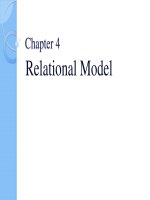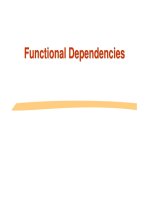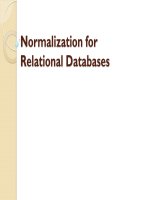Distributed Database Management Systems: Lecture 35
Bạn đang xem bản rút gọn của tài liệu. Xem và tải ngay bản đầy đủ của tài liệu tại đây (196.28 KB, 42 trang )
Distributed Database
Management Systems
Lecture 35
In the previous lecture
• Query Optimization
• Centralized QO
–Best access path
–Join Processing
• QO in Distributed
Environment.
In this lecture
• Query Optimization
–Fragmented Queries
–Joins replaced by Semijoins
–Three major QO algorithms.
Semijoin based
Algorithms
• Reduces cost of join
queries
• Semijoin is …….
• Join of two relations
can be replaced SJ of
one or both relations.
• So R ⋈A S can be replaced:
– (R ⋉A S) ⋈A S
– R ⋈A (S ⋉A R)
– (R ⋉A S) ⋈A (S ⋉A R)
• Which one?
• Need to estimate costs.
• Same Assumptions:
–R at site 1, S at site 2
–Size (R) < Size (S), so
– A (S) site 1
–Site1 computes R’ = R ⋉A S’
–R’ site 2
–Site2 computes R’ ⋈A S
• Ignoring Tmsg semijoin is
better if
–Size( A(S)) + size(R ⋉A S) <
size(R)
• Join is better if …..• Semijoin is better if…..-.
• SJ with more than two
tables Will be more
complex
• Semijoin approach can be
applied to each individual
join, consider
EMP ⋈ ASG ⋈ PROJ
• EMP ⋈ ASG ⋈ PROJ =
• EMP’ ⋈ ASG’ ⋈ PROJ
where
• EMP’ = EMP ⋉ ASG and
• ASG’ = ASG ⋉ PROJ
rather
• EMP” = EMP ⋉ (ASG ⋉
PROJ)
• Many SJ expressions
possible for a relation
• “Full reducer” a SJ
expression that reduces R
the maximum
• Not exists for cyclic
queries.
• Select eName From
EMP, ASG, PROJ
Where
EMP.eNo = ASG.eNo and
ASG.eNo = PROJ.eNo and
EMP.city = PROJ.city
ASG
pNo
eNo
EMP
city
PROJ
Cyclic Query
ASG
eNo, city
EMP
Tree Query
pNo, city
PROJ
• Full Reducer may be hard
to find.
• Easy for a chained query
• Most systems use single
SJs to reduce relation
size.
Distributed Query
Processing Algorithms
• Three main
representative algos are
–Distributed INGRES Algorithm
–R* Algorithm
–SDD-1 Algorithm.
R* Algorithm
• Static, exhaustive
• Algorithm supports
fragmentation, actual
implementation doesn’t
• Master, execution and
apprentice sites.
• Optimizer of Master site
makes inter-site decisions
• Apprentice sites make local
decisions
• Optimizes local processing
time & communication time.
• Optimizer, based on
stats of DB and size of
iterm results, decides
about
–Join Ordering
–Join Algo (nested/mergeJoin)
–Access path (indexed/seq.).
• Inter-site transfers
– Ship-whole
• Entire relation transferred
• Stored in a temp relation
• In case of merge-join approach, tuples can
be processed as they arrive
– Fetch-as-needed
• nExternal relation is sequentially scanned
• Join attribute value is sent to other relation
• Relevant tuples scanned at other site and
sent to first site.
• Inter-site transfers: comparison
– Ship-whole
• larger data transfer
• smaller number of messages
• better if relations are small
– Fetch-as-needed
• number of messages = O(cardinality of
external relation)
• data transfer per message is minimal
• better if relations are large and the join
selectivity is good.
• Example, join of an
external relation R
with an internal
relation S, there are
four strategies.
1-Move outer relation tuples to
the site of the inner relation
• Can be joined as they arrive
• Total Cost =
LT (retrieve card(R) tuples
from R)
+ CT (size(R)) +
LT (retrieve s tuples from S) *
card (R)
2- Move inner relation to the site of
outer relation
• cannot join as they arrive; they need
to be stored
• Total Cost = LT (retrieve card(S)
tuples from S) + CT (size (S)) +
LT (store card(S) tuples as T) +
LT (retrieve card(R) tuples from R) +
LT (retrieve s tuples from T) * card
(R).
3- Fetch inner tuples as
needed
• For each tuple in R, send join
attribute value to site of S
• Retrieve matching inner
tuples at site S
• Send the matching S tuples to
site of R
• Join as they arrive









